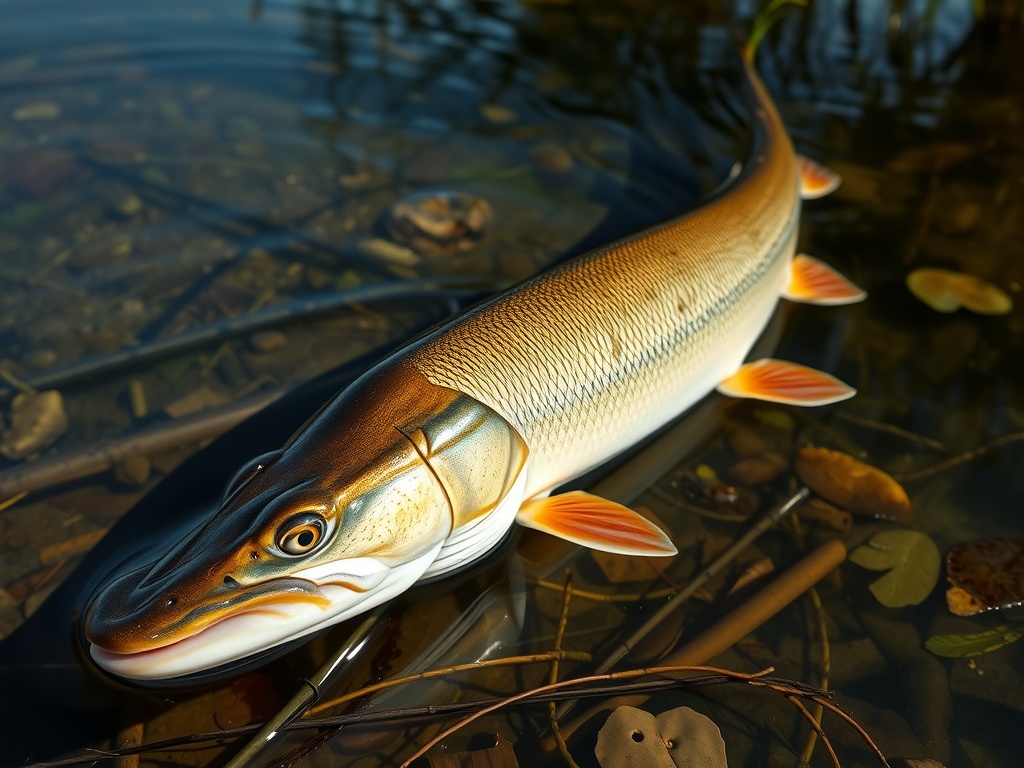
Northern pike
Esox lucius

Meet the Northern pike
The Northern pike is a large, predatory freshwater fish known for its elongated body, pointed snout, and sharp teeth. It has a distinctive green to gray coloration with lighter, irregular spots along its sides, providing excellent camouflage among aquatic vegetation. This species is highly territorial and ambushes prey such as fish, amphibians, and small mammals. Renowned among anglers for its aggressive strikes and fighting ability, the Northern pike is found across much of the Northern Hemisphere. Its adaptability allows it to thrive in a wide range of freshwater habitats, from weedy lakes to slow-moving rivers.
Classification
Fish
Habitat
Freshwater lakes, rivers, and marshes
Diet
Carnivore
Lifespan
10-15 years
Conservation
Least Concern
Weight
2–16 kg (4.4–35 lbs), occasionally up to 28 kg (62 lbs)
📖Fascinating Facts
Impressive Size
Northern pike can grow over 1.3 meters (4.3 feet) in length and are among the largest freshwater predatory fish in the world.
Razor-Sharp Teeth
They have rows of sharp, backward-facing teeth designed to grip slippery prey, making escape nearly impossible.
Wide Distribution
The Northern pike is found throughout North America, Europe, and parts of Asia, thriving in diverse freshwater environments.
📋Detailed Description
The Northern pike (Esox lucius) is a robust, torpedo-shaped predatory fish, typically reaching lengths of 45–75 cm, though exceptional specimens can exceed 130 cm and weigh over 20 kg. Its body is streamlined for rapid acceleration, with a long, flattened snout and a large mouth lined with numerous backward-pointing, needle-sharp teeth adapted for grasping slippery prey. The dorsal and anal fins are set far back on the body, enhancing its ability to lunge explosively at prey from ambush. Its coloration ranges from olive green to gray, with pale, irregular spots and a whitish belly, providing camouflage among aquatic vegetation. Northern pike have well-developed lateral lines for detecting vibrations, aiding in hunting. They are solitary and highly territorial, often occupying and defending specific areas within their home range. Pike are primarily ambush predators, but will also actively pursue prey when necessary. They inhabit a variety of freshwater environments, including lakes, slow-moving rivers, marshes, and brackish coastal waters, demonstrating remarkable ecological plasticity. During winter, they remain active under ice, utilizing slow metabolism and opportunistic feeding to survive harsh conditions.
💡 Did you know?
Northern pike have been known to occasionally prey on waterfowl and even small mammals that venture near the water's edge.
🔬Research & Sources
Wikipedia Summary
The northern pike is a species of carnivorous fish of the genus Esox (pikes). They are commonly found in moderately salty and fresh waters of the Northern Hemisphere. They are known simply as a pike in Great Britain, Ireland, most of Eastern Europe, Canada and the U.S., although in the Midwestern United States, they may just be called a Northern.
Last Modified: 5/14/2025
🎭Behavior & Social Structure
Northern pike are predominantly solitary, exhibiting strong territoriality, especially among adults. They are crepuscular, with peak hunting activity at dawn and dusk, though feeding can occur throughout the day. Pike rely on stealth and camouflage, remaining motionless among aquatic plants before launching rapid, short-distance attacks on passing prey. Their diet is opportunistic and includes fish (often conspecifics), amphibians, small mammals, waterfowl, and occasionally invertebrates. Juveniles form loose aggregations in shallow, vegetated areas for protection, but become increasingly solitary as they mature. Aggressive interactions, including cannibalism, are common, particularly in resource-limited environments. Pike exhibit site fidelity, often returning to favored hunting grounds. In winter, they reduce activity but continue to feed, often targeting slower, winter-stressed fish.
👶Reproduction & Life Cycle
Northern pike are spring spawners, with breeding typically occurring soon after ice melt when water temperatures reach 6–12°C. Spawning takes place in shallow, flooded areas with dense vegetation, such as marshes or inundated meadows. Females, which are larger than males, release between 15,000 and 75,000 adhesive eggs per kilogram of body weight, which are fertilized externally by multiple males. There is no parental care; eggs are left to develop on submerged vegetation. Incubation lasts 10–15 days depending on temperature. Larvae are initially planktonic, feeding on zooplankton before transitioning to piscivory as they grow. Juvenile mortality is high due to predation and cannibalism. Sexual maturity is reached at 2–4 years in males and 3–5 years in females, with longevity up to 15–25 years in the wild.
🛡️Adaptations & Survival
Northern pike possess several key adaptations for predation and survival. Their elongated, muscular bodies and posteriorly positioned fins enable sudden bursts of speed for ambush attacks. The large, tooth-filled mouth allows them to seize and hold large, slippery prey. Their cryptic coloration and ability to remain motionless make them effective ambush predators. Pike have a highly developed lateral line system for detecting prey movements, even in low-visibility conditions. Physiologically, they tolerate a wide range of temperatures and oxygen levels, enabling survival in diverse habitats, including brackish waters. Their ability to switch diets and cannibalize conspecifics provides a buffer against food scarcity.
🎨Cultural Significance
The Northern pike holds significant cultural value in many regions. It is a prized game fish, renowned for its size, fighting ability, and culinary qualities, featuring prominently in recreational and subsistence fisheries across Europe, Russia, and North America. In folklore and mythology, the pike is often depicted as a cunning and formidable creature, symbolizing strength and aggression. In Scandinavian and Slavic traditions, it appears in fairy tales and proverbs. Historically, pike have been featured in heraldry and as a food source for centuries, with records of their consumption dating back to medieval Europe.
🔬Recent Research & Discoveries
Recent research on Northern pike has focused on their role as apex predators in freshwater ecosystems, trophic interactions, and the ecological impacts of their introduction to non-native habitats. Genetic studies have revealed significant population structuring across their range, with evidence of local adaptation and hybridization with related species (e.g., Amur pike, Esox reichertii) in overlapping zones. Advances in telemetry and tagging have provided insights into movement patterns, habitat use, and responses to environmental change. Studies on pike as bioindicators highlight their sensitivity to water quality and ecosystem health. Ongoing research is investigating the effects of climate change on spawning phenology and recruitment success.
🎥Wildlife Videos

The Fascinating Wildlife in Deep Mountain Lakes | Full Documentary
Germany's inland waterways, rivers, streams and lakes are a colourful and, in some cases, virtually untouched natural refuge.
Free High-Quality Documentaries

Northern Pike Facts: the WOLF of the POND | Animal Fact Files
The northern pike is a fish that is also known as the wolf of the pond for its voracious attitude. Northern pikes have duck-bill ...
Animal Fact Files

Wild Canada - Nature's Untamed Beauty | Full Series | Free Documentary Nature
Wild Canada - Nature's Untamed Beauty | Wildlife Documentary Watch 'Darkwoods - Canada's Hidden Nature Reserve' here: ...
Free Documentary - Nature

Northern Pike - Amazing Animal
Thanks for watching the video! LIKE, SHARE, COMMENT & SUBSCRIBE!!!!! I hope you subscribe to join the Squad! Make sure to ...
NORTH 02

Invasive Northern Pike
This video is part of the northern pike awareness campaign the Kenai Fish and Wildlife Field Office and the Alaska Department of ...
U.S. Fish & Wildlife Service

The Depths of the North Sea: Life in the Cold Abyss | Secrets of the Seas Ep. 1 | 4K UHD Documentary
"Seas in Motion - Wonders of the North Sea" unveils the dynamic ecosystem of one of Europe's most vital bodies of water.
space and science
🌍Habitat Information
The Northern pike typically inhabits Freshwater lakes, rivers, and marshes environments. Northern pikes have adapted to their environments with specialized features and behaviors.
Primary Habitat:
Freshwater lakes, rivers, and marshes
More detailed habitat information will be available soon.
🛡️Conservation Status
The Northern pike is currently classified as Least Concern. Conservation efforts are crucial for preserving this species for future generations.
Common Threats:
- 🏠Habitat loss and fragmentation
- 🌡️Climate change impacts
- 🎯Hunting and poaching
- 🏭Human-wildlife conflict
⚠️Threats & Conservation Challenges
While the Northern pike is currently listed as Least Concern by the IUCN, localized threats include habitat loss due to wetland drainage, pollution, and the construction of barriers that impede spawning migrations. Overfishing and unregulated angling can impact local populations, particularly of large, mature females crucial for reproduction. Invasive introductions outside their native range have led to ecological imbalances, with pike preying on native fish species and altering community dynamics. Climate change may affect spawning habitats through altered hydrology and temperature regimes. Despite these challenges, the species' adaptability and high reproductive output have allowed it to maintain stable populations across much of its range.
🔬Scientific Classification
Scientific Name
Esox lucius
Classification Hierarchy
🔍 About Taxonomic Classification
Taxonomic classification is a hierarchical system used by scientists to classify and organize living organisms based on shared characteristics and evolutionary relationships.
The system moves from broad categories (Kingdom) to increasingly specific ones, with each animal's scientific name typically consisting of its Genus and species.
📝Community Notes
Share your observations and insights about the Northern pike with our community of wildlife enthusiasts.
Join Our Community
Sign in to share your observations and connect with fellow wildlife enthusiasts.
Sign In to ContributeNo community notes yet
Be the first to share your observations about the Northern pike!
Explore Northern pike
Select a tab above to learn more about this amazing animal.
📸Photo Gallery
No photos available for this animal yet.
🌟Discover More Wildlife
Continue your journey of discovery with more fascinating animals from our database
